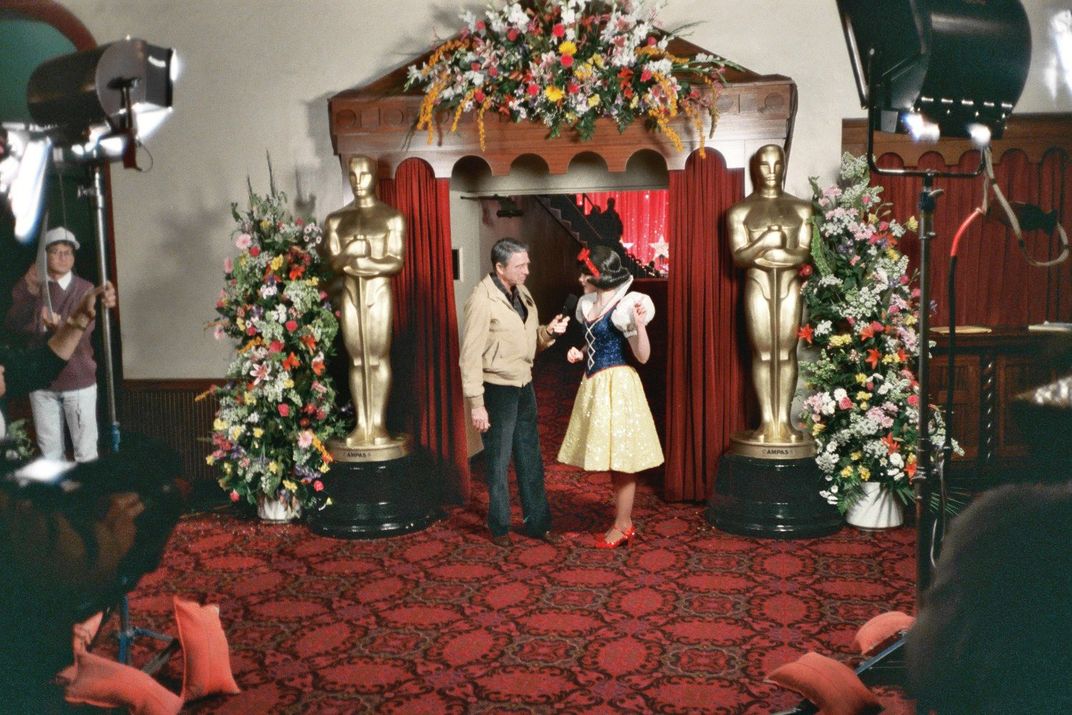A Smithsonian Folklorist Delves Into the Rituals and Rewards at the Academy Awards
Folk belief holds that if you have won one Oscar, your odds of ever winning a second are greatly diminished by the dreaded “Oscar Jinx”
/https://tf-cmsv2-smithsonianmag-media.s3.amazonaws.com/filer/bb/5c/bb5c773a-bc4f-4bf8-a0b6-02f51b5da110/gettyimages-649353156.jpg)
Folklorists look for patterns. Maybe not the patterns in the Vera Wang gowns that so many glamorous stars wore at the 91st Academy Awards ceremony on Sunday, February 24, 2019 in Hollywood. But certainly, the patterns in the ritual event itself—the customs, beliefs, traditions and formulas, which we collectively call folklore—that are repeated year after year.
The first Academy Awards were presented on May 16, 1929, at a private dinner in a Hollywood hotel ballroom for 270 guests, hosted by the Academy of Motion Picture Arts and Sciences (AMPAS), which had been established in early 1927. In attendance was much of Hollywood royalty: the god-like stars whose faces were larger than life on the silver screen. We know relatively little about the 1929 event or its rituals, other than the names of the winners, because it was not broadcast in any form.
The 1930 Academy Awards were the first to be broadcast on radio. Television began its live broadcasts on March 19, 1953, which has profoundly affected the nature of the event—now bringing it to an estimated 30 to 40 million viewers each year.
Much folklore exists in different versions, known to folklorists as variants, because there is rarely a single source considered definitive or authoritative. For instance, several variants exist to explain why the Academy Awards are known as Oscars. One variant cites actress Bette Davis (winner of two Academy Awards), who allegedly said that the svelte gold-plated statuette reminded her of Harmon Oscar Nelson (her husband at the time) because both had shallow backsides. Another variant traces the name to Oscar Wilde, the Irish playwright and poet, who, after receiving the Newdigate Prize for Poetry, told reporters that “every year some man gets the Newdigate, but not every year does Newdigate get an Oscar.” That sounds intriguing, except that Wilde made this statement in January 1882. The most widely accepted variant traces the origin to Margaret Herrick, the first librarian and subsequently executive director of AMPAS, who supposedly claimed that the statuette was reminiscent of her “Uncle Oscar.” Skeptics note that Oscar Pierce was her second cousin, not her uncle.
Fortune and luck—as well as misfortune and bad luck—often appear in folk beliefs and customs. For instance, we believe that four-leaf clovers and horseshoes will bring good luck. Walking under ladders and black cats crossing our path are omens of bad luck. For those in the film industry, there is one belief that even uttering the word “Oscar”could spoil your chances of winning one. Actor Saoirse Ronan supposedly avoided saying the word “Oscar” for one month before the 2016 Academy Awards ceremony, when her performance in Brooklyn (2015) put her in the running for Best Actress—albeit unsuccessfully.

Another folk belief holds that if you have won one Oscar, your odds of ever winning a second are greatly diminished by the dreaded “Oscar Jinx.” In this category are Timothy Hutton, who at age 20 became the youngest ever winner of Best Supporting Actor for his performance in Ordinary People (1980), but he has since failed to find comparable success. Similarly, F. Murray Abraham received the award for Best Actor for his performance in Amadeus (1984), and has appeared in some 50 theatrical films since then, but without even earning another Oscar nomination.
One variant on this jinx, known as the “Oscar Love Curse,” holds that female winners of an Academy Award may suffer misfortune in their love lives after taking home the Oscar. In this category of those affected by break-ups, separations and divorces are Halle Berry, Hilary Swank and several others. Of course, there are many exceptions to these jinxes—Meryl Streep and Daniel Day Lewis, among others—but (in folk belief) the exceptions usually receive less attention than the victims.
Any discussion of folklore and the Oscars must include the customs practiced by viewers at home, who eagerly tune in each year to watch what host Johnny Carson in 1979 jokingly called “two hours of sparkling entertainment spread out over a four-hour show.”
Like all folk rituals, watching the star-studded ceremonies involves moments that we anticipate, if not almost demand. There will be truly embarrassing acceptance speeches. Someone will be attired in ways that we can’t stop talking about the next morning. And there may even be moments that we can’t stop talking about for years—from the disastrous Snow White appearance in 1989 to the bewildering confusion in 2017 when the award for Best Picture was mistakenly given to La La Land instead of Moonlight—corrected only after the producers of the former were halfway through their acceptance speeches.
Folklore serves several functions, including amusement, education and the reinforcement of beliefs and conduct. But its foremost function is to help maintain the stability, solidarity, cohesiveness and continuity of different groups within the larger mass culture. By producing the Oscars each year, the Academy of Motion Pictures Arts and Sciences is able to maintain its cohesiveness and solidary even while its members compete against each other.
And for the viewers at home, the ceremonial rituals confirm our beliefs in—and sometimes our hopes for—the glamor of Hollywood royalty. We might take some pleasure in a nominee’s misfortune—as in that lovely German word schadenfreude. But we almost always delight in the spectacle of the red carpet, which, according to one interpretation, is akin to the “crimson path” upon which gods and goddesses walk when they return to earth. Once upon a time.
A version of this article originally appeared on the digital magazine of the Smithsonian Center for Folklife and Cultural Heritage.
/https://tf-cmsv2-smithsonianmag-media.s3.amazonaws.com/accounts/headshot/James_Deutsch.jpg)
/https://tf-cmsv2-smithsonianmag-media.s3.amazonaws.com/accounts/headshot/James_Deutsch.jpg)